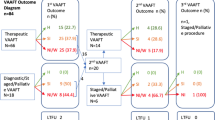Abstract
Background
It was the aim of this prospective study to analyze both the feasibility and preliminary results of video-assisted anal fistula treatment (VAAFT) combined with advancement flap repair for complex fistulas in Crohn's disease.
Methods
All patients with perianal Crohn's disease suffering from complex fistulas who underwent definitive surgery using VAAFT combined with advancement flap repair were prospectively enrolled in the study. Only complex fistulas with concurrent stable disease and without any evidence of severe inflammatory activity or perianal sepsis were treated using the VAAFT technique. Patients with Crohn's proctitis or prior proctectomy were not candidates for the procedure. VAAFT was performed by using the VAAFT equipment (Karl Storz, Tuttlingen, Germany). Key steps included visualization of the fistula tract and/or side tracts using the fistuloscope and correct localization of the internal fistula opening under direct vision with irrigation. Diagnostic fistuloscopy was followed by advancement flap repair. In addition to feasibility, primary end points included detection of side tracts, success and continence status (assessed by the Cleveland Clinic Incontinence Score). Success was defined as closure of both internal and external openings, absence of drainage without further intervention and absence of abscess formation. Follow-up information was derived from clinical examination 3, 6 and 9 months postoperatively.
Results
Within a 3-month observation period (September to November 2011), VAAFT was attempted in 13 patients with Crohn's associated complex fistulas. The completion rate was 85 % (11/13). In these 11 patients (median age 34 years, 64 % females), complex fistulas were transsphincteric (8), suprasphincteric (2) and recto-vaginal (1). Forty-six percent (5/11) had concomitant therapy with biologic drugs. In 36 % (4/11), VAAFT was performed with fecal diversion. Median duration of surgery was 22 (range 18–42) minutes. Using VAAFT, additional side tracts not detected preoperatively could be identified in 64 % (7/11). No morbidity occurred. After a mean follow-up of 9 months, the success rate was 82 % (9/11). No deterioration of continence was documented (Cleveland Clinic Incontinence Score 2.4 vs. 1.6, p > 0.05).
Conclusion
Preliminary results of the addition of the VAAFT technique to advancement flap repair in Crohn's fistulas demonstrate that this leads to a high identification rate of occult side tracts with encouraging short-term healing rates. Moreover, a completion rate of 85 % seems promising.


Similar content being viewed by others
References
Mizrahi N, Wexner SD, Zmora O et al (2002) Endorectal advancement flap: are there predictors of failure? Dis Colon Rectum 45:1616–1621
Sonoda T, Hull T, Piedmonte MR, Fazio VW (2002) Outcomes of primary repair of anorectal and rectovaginal fistulas using the endorectal advancement flap. Dis Colon Rectum 45:1622–1628
Löffler T, Welsch T, Mühl S, Hinz U, Schmidt J, Kinele P (2009) Long-term success rate after surgical treatment of anorectal and rectovaginal fistulas in Crohn's disease. Int J Colorectal Dis 24:521–526
Meinero P, Mori L (2011) Video-assisted anal fistula treatment (VAAFT): a novel sphincter-saving procedure for treating complex anal fistulas. Tech Coloproctol 15:417–422
Hannaway CD, Hull TL (2008) Current considerations in the management of rectovaginal fistula from Crohn's disease. Colorectal Dis 10:747–755
Andreani SM, Dang HH, Grondona P, Khan AZ, Edwards DP (2007) Rectovaginal fistula in Crohn’s disease. Dis Colon Rectum 50:2215–2222
Joo JS, Weiss EG, Nogueras JJ, Wexner SD (1998) Endorectal advancement flap in perianal Crohn’s disease. Am Surg 64:147–150
Schwandner O (2011) Obesity is a negative predictor of success after surgery for complex anal fistula. BMC Gastroenterol 11:61
Jorge JM, Wexner SD (1993) Etiology and management of fecal incontinence. Dis Colon Rectum 36:77–97
Tozer PJ, Burling D, Gupta A, Phillips RK, Hart AL (2011) Review article: medical, surgical and radiological management of perianal Crohn's fistulas. Aliment Pharmacol Ther 33:5–22
Bourikas LA, Koutroubakis IE (2010) Anti-TNF and fistulizing perianal Crohn's disease: use in clinical practice. Curr Drug Targets 11:187–197
Karmiris K, Bielen D, Vanbeckevoort D et al (2011) Long-term monitoring of infliximab therapy for perianal fistulizing Crohn's disease by using magnetic resonance imaging. Clin Gastroenterol Hepatol 9:130–136
Bode M, Eder S, Schürmann G (2008) Perianal fistulas in Crohn's disease—biologicals and surgery: is it worthwhile? Z Gastroenterol 46:1376–1383
van der Hagen SJ, Baeten CG, Soeters PB, Russel MG, Beets-Tan RG, van Gemert WG (2005) Anti-TNF-alpha (infliximab) used as induction treatment in case of active proctitis in a multistep strategy followed by definitive surgery of complex anal fistulas in Crohn's disease: a preliminary report. Dis Colon Rectum 48:758–767
Hyder SA, Travis SP, Jewell DP, McC Mortensen NJ, George BD (2006) Fistulating anal Crohn's disease: results of combined surgical and infliximab treatment. Dis Colon Rectum 49:1837–1841
El-Gazzaz G, Hull T, Church JM (2012) Biological immunomodulators improve the healing rate in surgically treated perianal crohn's fistulas. Colorectal Dis 14:1217–1223
Schwandner O, Fuerst A, Kunstreich K, Scherer R (2009) Innovative technique for the closure of rectovaginal fistula using Surgisis mesh. Tech Coloproctol 13:135–140
Sciaudone G, Di Stazio C, Limongelli P et al (2010) Treatment of complex perianal fistulas in Crohn disease: infliximab, surgery or combined approach. Can J Surg 53:299–304
Duff S, Sagar PM, Rao M, Dolling S, Sprakes M, Hamlin PJ (2011) Infliximab and surgical treatment of complex anal Crohn's disease. Colorectal Dis 14:972–976
Acknowledgments
The author thanks PD Dr. Christoph Isbert, Department of Surgery, University of Wuerzburg, for providing the drawings of anal fistula.
Conflict of interest
No conflict of interest exists.
Author information
Authors and Affiliations
Corresponding author
Rights and permissions
About this article
Cite this article
Schwandner, O. Video-assisted anal fistula treatment (VAAFT) combined with advancement flap repair in Crohn’s disease. Tech Coloproctol 17, 221–225 (2013). https://doi.org/10.1007/s10151-012-0921-7
Received:
Accepted:
Published:
Issue Date:
DOI: https://doi.org/10.1007/s10151-012-0921-7




